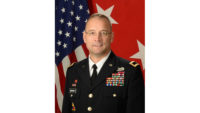The U.S. Army has announced several changes among senior positions at the Corps of Engineers, including designation of a new deputy chief of engineers, the Corps’ No. 2 official.
Lt. Gen. Todd T. Semonite remains Corps commanding general and Army chief of engineers, positions he has held since May 2016. In recent years, Corps chiefs have served terms of about four years. The Corps' top echelon manages billions of dollars of military and civil-works construction each year.
The new Corps appointments are among 43 senior officer reassignments that the Army chief of staff announced on Feb. 19.
Leading the list of Corps changes is the selection of Maj. Gen. Richard G. Kaiser to be deputy chief of engineers and deputy commanding general. Kaiser has led the Corps’ Mississippi Valley Division since September 2017.
He will succeed Maj. Gen. Michael C. Wehr, Corps deputy chief since September 2017, who will move to the U.S. Transport Command, where he will be director of strategy, capabilities, policy, programs and logistics.
Those moves will have a ripple effect. Replacing Kaiser at the Mississippi Valley Division is Maj. Gen. Richard M. (Mark) Toy, who since August 2016 has commanded the Corps’ Great Lakes and Ohio River Division, which is headquartered in Cincinnati.
Taking Toy’s place will be Brig. Gen. Robert F. Whittle Jr., who now is commandant of the U.S. Army Engineer School at Fort Leonard Wood in Missouri.
Whittle’s successor will be Col. Mark C. Quander, commander of the Corps’ Transatlantic Division, based in Winchester, Va. Quander’s replacement has not yet been announced.
“The guys who are moving are all top performers—all of them—at least as far as the civil works program folks are concerned,” says John Doyle, special counsel with law and lobbying firm Jones Walker LLP.
Kaiser, Wehr and Toy also could be among candidates to succeed Semonite as the next Chief of Engineers, suggests Doyle, a former top Army civil works official. Others could end up on the list, too.
Doyle says the timing of the release of the new-assignment list is “standard Army protocol.” He notes that the Army tends to announce a batch of general-officer assignments in late winter or early spring, so officers and their families can begin relocation plans. Actual changes in command won’t occur for several months.



Post a comment to this article
Report Abusive Comment